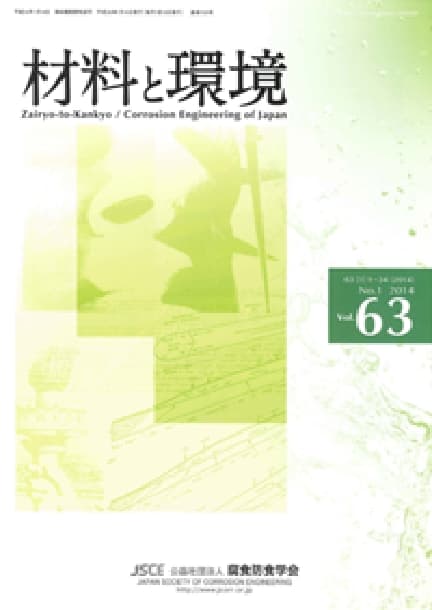- TOP
- Zairyo-to-Kankyo
- Vol. 65 (2016), No. 3
Zairyo-to-Kankyo Vol. 65 (2016), No. 3
Backnumber
-
Vol. 74 (2025)
-
Vol. 73 (2024)
-
Vol. 72 (2023)
-
Vol. 71 (2022)
-
Vol. 70 (2021)
-
Vol. 69 (2020)
-
Vol. 68 (2019)
-
Vol. 67 (2018)
-
Vol. 66 (2017)
-
Vol. 65 (2016)
-
Vol. 64 (2015)
-
Vol. 63 (2014)
-
Vol. 62 (2013)
-
Vol. 61 (2012)
-
Vol. 60 (2011)
-
Vol. 59 (2010)
-
Vol. 58 (2009)
-
Vol. 57 (2008)
-
Vol. 56 (2007)
-
Vol. 55 (2006)
-
Vol. 54 (2005)
-
Vol. 53 (2004)
-
Vol. 52 (2003)
-
Vol. 51 (2002)
-
Vol. 50 (2001)
-
Vol. 49 (2000)
-
Vol. 48 (1999)
-
Vol. 47 (1998)
-
Vol. 46 (1997)
-
Vol. 45 (1996)
-
Vol. 44 (1995)
-
Vol. 43 (1994)
-
Vol. 42 (1993)
-
Vol. 41 (1992)
-
Vol. 40 (1991)
Keyword Ranking
20 Nov. (Last 30 Days)
Zairyo-to-Kankyo Vol. 65 (2016), No. 3
Diagnosis of Copper Tube Corrosion by Water Quality Analysis of Cooling Water Flowing Through Copper Heat Exchanger of Air-conditioner
Yoshinao Hoshi, Kentaro Ochi, Isao Shitanda, Masayuki Itagaki, Kyouichi Sekiguchi, Youichi Hirata, Takashi Hishinuma
pp. 88-94
DOI:
10.3323/jcorr.65.88Abstract
The tendency of pitting corrosion on copper tubes of heat exchangers was investigated by analyzing the quality of cooling water sampled from air-conditioning units at different cities in Japan. A two-dimensional diagram (2DD) was constructed with two parameters chosen from water quality conditions, i.e., total hardness, acid consumption, pH, concentrations of SO42― and Cl―. The results of 2DD analyses demonstrated that the acid consumption was strongly related to the susceptibility of copper pitting corrosion. In order to make a diagnosis of copper pitting corrosion, we proposed a three-dimensional diagram (3DD). The axes of 3DD were the acid consumption, pH and ratio of amount of Cl― + SO42― ions to total anions (HCO3―, Cl― and SO42―). This diagram indicated that the cooling water sampled from air-conditioning units could be divided into high and low pitting corrosion risk categories precisely. In addition, the simulated cooling water was prepared in the laboratory to assist the effectiveness of the proposed 3DD analysis. The anodic polarization curves of copper electrode were measured in the simulated cooling water as the accelerated test for pitting corrosion susceptibility. The 3DD analysis was applied to the discrimination of corrosive properties of simulated cooling water after accelerated test. The surface morphology of copper electrode was analyzed by the optical microscope. The results of 3DD analyses were in good agreement with those of surface morphologies of copper electrode after anodic polarization curve measurement. These results implied that 3DD allowed the screening of cooling water related to the risk of pitting corrosion on copper tubes of heat exchangers.
Corrosion Protection of Metals and Oxidized Metals by Ultrathin Two-Dimensional Polymer Coatings Prepared by Chemical Modification of Three Types of Self-Assembled Monolayers
Kunitsugu Aramaki, Tadashi Shimura
pp. 95-102
DOI:
10.3323/jcorr.65.95Abstract
Three types of self-assembled monolayers (SAMs) were prepared on metals and oxidized metals. They are an alkanethiol SAM chemically adsorbed on Cu and Fe, a benzene derivative SAM adsorbed on Fe by the formation of an Fe-C covalent bond and a carboxylate ion SAM chemisorbed on the surfaces of passivated Fe and hydrated Ce2O3 layer-coated Zn. Ultrathin (nm order thickness), ordered (self-assembly) and interconnected (two-dimensional polymer) protective coatings were synthesized by chemical modification of the SAMs adsorbed on metals and oxidized metals with silane coupling agents. The protective effects of these coatings on corrosion of substrate metals and passive film breakdown in oxygenated neutral solutions are summarized in this paper. The protective efficiency of the polymer coating on Cu in aerated 0.5 M Na2SO4 was extremely high, 99.3% at 1 h of the immersion time but decreased markedly after 20 h. The polymer coating of the benzene derivative SAM protected Fe from corrosion in the long range of the immersion time. Complete protection against corrosion of Fe was accomplished by coverage of a passivated Fe electrode with the two-dimensional polymer coating in the solutions, unless the passive film was broken down.
Article Access Ranking
20 Nov. (Last 30 Days)
-
Perspectives on the Promising Pathways to Zero Carbon Emissions in the Steel Industry toward 2050
ISIJ International Vol.65(2025), No.2
-
Integrated Steelworks that Reduce CO2 Emissions by More Than 80% ─ Challenge for Carbon-Neutral Integrated Steelworks ─
Tetsu-to-Hagané Vol.111(2025), No.13
-
A new simulation characterization method to reveal the causes of cracking for cast iron cooling staves
ISIJ International Advance Publication
-
Advanced Coil Cooling Model Incorporating Layering and Interface Effects of Strip Windings
ISIJ International Vol.65(2025), No.11
-
Progress of Strip Casting Technology for Steel; Historical Developments
ISIJ International Vol.52(2012), No.12
-
Steel Cleanness Evaluation: Framework for Inclusion Characterization by Means of Automated and Manual SEM/EDS Analysis and Computational Thermodynamics
ISIJ International Advance Publication
-
New Electromagnetic Flow Control System for Optimization of Molten Steel Flow in Continuous Casting Mold
Tetsu-to-Hagané Advance Publication
-
Microstructures and Reduction Properties of High CaO Concentration Sintered Ore
ISIJ International Advance Publication
-
Development of New Cryogenic Steels for the Superconducting Magnets of the Fusion Experimental Reactor
ISIJ International Vol.30(1990), No.8
-
Effect of Baffles on the Mixing of Liquid and Particles in a Mechanically Stirred Vessel
Tetsu-to-Hagané Vol.90(2004), No.6
You can use this feature after you logged into the site.
Please click the button below.










